How to Build a CRM System: Detailed Overview
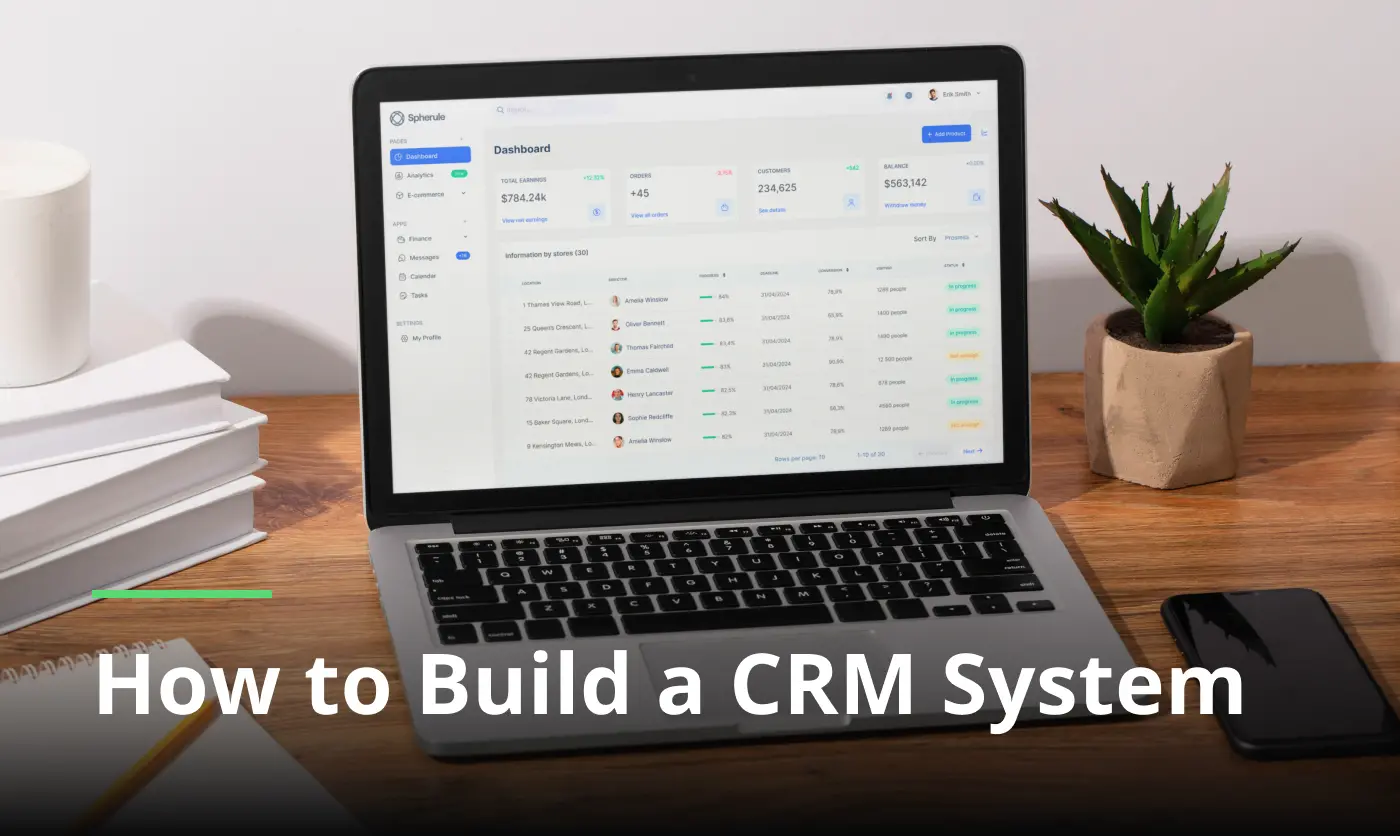
Today, businesses are forced to adapt to a highly competitive environment, and CRM development can make this path much more manageable. Customer relationship management contributes tools for accounting for key indicators, building sales department communication with clients, and other crucial processes, which we will discuss in our review.
In order to not only communicate with your users but also interact with them effectively and efficiently, you need to create a CRM system that takes all the critical aspects into account. And in close cooperation with our experts, we have compiled such an outline that will shed light on most questions about software development services.
After reading this synopsis of CRM software development, you will be fully armed, knowing much more about the manner of generating and launching ideally generated services since we have tried to present all our ten years of experience in synthesizing productive solutions in the most accessible and structured way.
What is a CRM system?
Sometimes, building relationships with customers becomes problematic for business owners due to a fairly wide audience and the inability to track their activity with simple and familiar actions. This is where a client connection system platform comes into play, the role of which also consists of centralizing data, tracking interactions, automating workflows and improving patron retention strategies.
“What is CRM software development?” The answer begins with the understanding that this composition uses data analysis on preferences and behavioral patterns to bring deep analytical information about clients and leads. However, due to the growing popularity of this approach, the acronym has also extended to the digital toolkit and software used for these schemes.
It is safe to say that relationship intelligence tool is an imperative marketing asset for any enterprise carried out in today’s digital presence. In addition to storing entries on current and regular guests and analyzing past interactions, such a tool significantly facilitates dialog between consumers and company representatives.
How to create a CRM system in 5 steps?
When thinking about using such platforms, you have few options: a ready-made platform or a personalized innovation. The latter is the most preferable for many reasons because it will fully adjust to your operation ways and will be as seamless as possible with all existing assets. In addition, it can be scaled and adapted to future changes, and in this case, there is much more confidence in security.
Of course, such a solution will require additional resources. Still, if you need unique capabilities and are ready to hire software developers and invest in skimming the cream later, our 5-step guide will significantly assist.
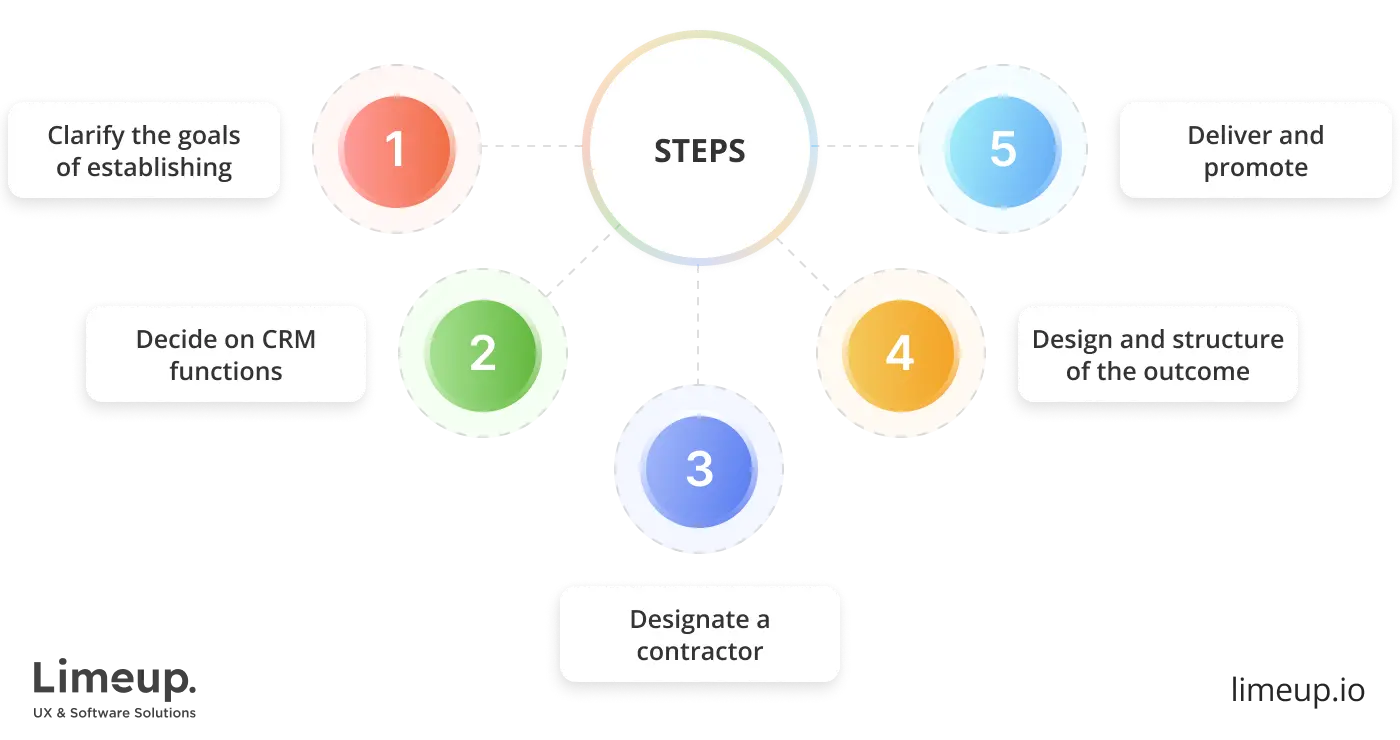
Step 1. Clarify the goals of establishing.
This is essential because it will help you understand what benefits the future object will bring to your brand and how it will increase your profits. Common goals may include improving buyer service, increasing selling, improving visitor retention strategies, improving internal dealings, and so on.
After determining priorities, you can begin to select the preferred type of CRM software development. Depending on the purpose, they can be as follows:
- collaborative — aimed at improving teamwork by drawing on a transparent records exchange environment,
- analytical — tend in planning, providing facts, statistics and analytics,
- operational — focus on automating and optimizing workflow plans to improve work efficiency.solution
It should also be noted that several types of schemes can be combined in packages in order to make the most of the advantages and capabilities of each.
Step 2. Decide on CRM functions.
Some options do their part in the product management contacts, while others — track interactions or perform lead administration. Depending on your focus, CRM software design and development may have the following plugins:
- marketing module — most often includes campaign supervision capabilities, social media integration, analytics, segmentation function,
- sales module — may contain a dashboard for reviewing monthly tradings, for reviewing potential opportunities, a “Sales Funnel” view, as well as lead scoring,
- prospect abetment module — is an interface with the ability to view requests, prioritize and redirect tasks, store all findings about procedures and upshots, as well as statistics on problem resolution time and other parameters.
Almost always, a combination of these modules is used, which allows for a comprehensive backup of commercial strategies and takes them to a higher level.
Step 3. Designate a contractor.
After outlining the first sketches of the future custom CRM system development, it’s time to decide who will implement your ideas. There, too, there are several options:
- outsourcing — involves hiring external specialists who are not your permanent employees, which saves money and gives access to a larger pool of specialists,
- in-house construction — is carried out by hiring a crew for the long term with the provision of a workspace and the necessary equipment. With full control, however, you pay more and must worry about attracting and retaining technical talent.
In most cases, outsourcing is chosen due to the ability to find experts with niche expertise in any time zone and with greater budget variability.
Step 4. Design and structure of the outcome.
This stage of CRM system development is key and largely determines the future fate of the mechanism and the results you can achieve with it. Since buyers groups differ significantly and the amount of data to conduct is significant, there are quite a few parameters to consider. For example:
- roles and responsibilities of different emptors,
- logical organization of values and components,
- grouping of related modules and logs,
- design suite for consistency of elements,
- ability to adapt the infrastructure according to needs,
- adaptation processing units (contextual aid, tips and user guides).
Only by carefully analyzing each of the listed aspects will it be possible to build an invention that will not only work smoothly but also meet the expectations placed on it.
Step 5: Deliver and promote.
These types of customer relationship management software development typically follow the same execution roadmap as other similar utilities, meaning that once the item is built, it needs to be adequately launched and supported. Our masters shared tips on what to focus on during this period:
- generate a detailed specification describing the architecture, database design, structures, and technologies,
- generate a plan for migrating material from existing configurations to the new one,
- develop connectors for seamless integration,
- ensure responsiveness and accessibility across devices,
- test the code thoroughly, identify and fix bugs,
- ensure that the code and suite comply with regulations such as GDPR,
- plan the deployment line of action, including staging environments, user training, and rollback procedures,
- agree on a protocol for providing follow-up facilitation.
With such a thorough approach, you will have no chance of not getting the expected result, because you will foresee all possible troubles and problems.
What are the features of custom CRM software development?
Determining the functionality that should be present in a future deployment can sometimes be a difficult task for owners, especially if they have not previously encountered the technical field. However, the set of tools that the construction will be filled with will largely determine both the timing of its formation and the final cost. That is why we have compiled a list of the most useful functions so that you do not miss anything vital.
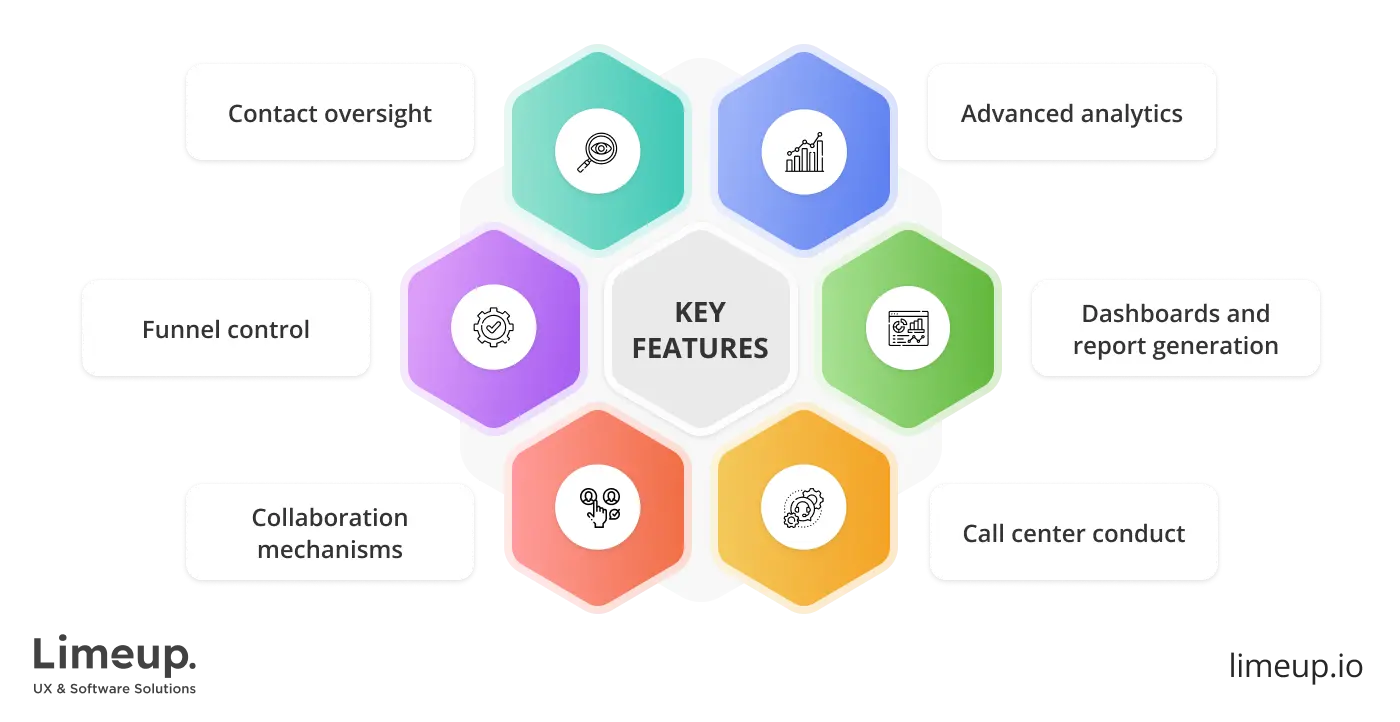
-
Contact oversight. This is the basis of any client connection system, allowing you to collect details on current and potential clients, automatically fill in their profiles, store a complete history of interactions and segment contacts into groups according to a number of criteria.
Depending on your requests, these can be basic characteristics (age, location) or more advanced ones to personalize offers, ensure user satisfaction, and conduct predictive analysis.
-
Funnel control. Visual representation of potential consumers in the retail cycle is the second most popular element of custom CRM development. The presence of such a function makes it easy to track the path of contacts from the first touch to the final stage of the deal, which means increasing transaction efficiency.
In addition, here, you can set up a fine-grained lead-scoring formula based on the most necessary criteria. As a result, you will be able to filter out leads with low scores and correctly prioritize your actions.
-
Collaboration mechanisms. There are a number of tools that do not directly affect buyer interactions, but significantly improve internal workflows. Thus, the mentioned collaborative activity modules stand to simplify synergism between individual employees and departments.
Let’s list just a few of these modules in building a CRM system: task distribution and direction, task completion monitoring, time tracking, event planning, reminders, and much more.
-
Advanced analytics. Storing large amounts of variables can only bring real value if you have powerful analytical resources built into the outcome. This allows you to process the information received and then arrange insights on various aspects of the activity.
In practice, the dedicated development team prefers to use a combination of such types of analysis as market segmentation, predictive, profitability, relationships, etc.
-
Dashboards and report generation. If you have collected a huge dataset but cannot interpret it, it is useless work. To present complex deets in a simple and convenient form, it is necessary to visualize the findings in diagrams, charts or graphs.
Besides, you will be able to assign different access rights so that division members see only the part that is relevant to them. And the report generation function will be needed to receive figures on a regular basis without a separate request.
-
Call center conduct. As already mentioned, one of the main tasks of implementing a lead management system is a more meaningful and consistent connection with leads. Innovations that govern the call center allow vending representatives to receive a history of all interactions with a specific person, which reduces the time to prepare for a call and optimizes the workflow.
This also makes it possible to call and send letters directly from the platform, without using additional resources.
The above list is neither exhaustive nor mandatory, these are just recommendations from our specialists on how to develop CRM software. Since every brand is unique, it is impossible to define a universal set of options that suit all organizations equally. That is why configured production allows you to add, change or remove any components at any time.
What tech stack is used for CRM system development?
Different types of technology toolsets are used in CRM development services. They can include variations of blueprints and frameworks that most appropriately solve the tasks. We will name those configurations that have proven themselves in practice in the best way, and therefore can be useful in your case.

— ASP.NET
This is one of the favorites in this direction, and the software made on its own can work on both Linux and Windows. The system leverages ASP.NET MVC for implementing the model-view-controller architecture, utilizes SQL Server for database management, employs IIS for accessing the Microsoft server, and integrates Azure for code deployment.
— MEAN Stack
If you are planning to build a CRM system with high scalability, this tech suite is the best choice. This is a source-available JavaScript toolkit intended for constructing interactive websites and web applications with lightweight codes, accelerated execution, and excellent information storage. Of the technologies, it uses MongoDB as a records storage, Express.js for backend production, AngularJS for frontend tasks, and NodeJS to run server JS scripts.
By the way, this software ecosystem has several worthy alternatives — MERN and MEVN.
— Ruby on Rails
It’s another representative of the group of lineups for code convergence, based on the Ruby programming language for developing backend codes. Rails is a comprehensive full-stack framework that includes all the essential tools required for developing exceptional web applications on both the client and server sides.
— HubSpot
While thinking about how to build CRM software, some experts consider this set to be one of the most productive and effective. This is a comprehensive platform within which various processing units are available, mainly used for optimizing the sales funnel and helping invent user interfaces, internal elements, plugins for integration, and datasets for storing details.
Based on these brief explanations, you can easily handpick or discuss the possibility of using one or another combination to successfully integrate sales automation software.
How much do CRM software development services cost?
From statistical research data, we know that the customer relationship management software market revenue has already reached $98.84 billion and the sector is expected to continue to expand steadily, resulting in a landscape size of US$145.61 billion by 2029. This is clear confirmation of the fact that this item is not only not losing its popularity but is confidently conquering new frontiers.
With the undeniable growth and impact of exclusive business relationship platforms on ventures worldwide, it is important to understand the factors that influence crafting costs and to have an idea of the approximate figures for these costs. In the table below, we grant average parameters and assess the project timeline and its details.
| Type of CRM | Time | Budget | Details |
| CRM for small business | A few weeks to a couple of months | ~$10,000 | Building CRM software can feature scheduling, online payments, automated emails and SMS, account holder records, and staff administration. |
| Standard custom CRM system | A few months, depending on features and complexity | Around $55,000 | This estimate uses an average developer rate of $20 – 25 per hour, but costs may jump to $70 – 100 per hour for developers from the US or Western Europe. |
| A comprehensive CRM system | Can take many months | Up to $345,000 | Complex offerings require specialized technical collectives and long development periods, resulting in high costs from their advanced modules. |
Of course, the final software development cost estimate will also be based on factors such as the feature and complexity, the type of toolset used, the presence of advanced elements, the level of CRM software developers, the volume of subsequent support and maintenance.
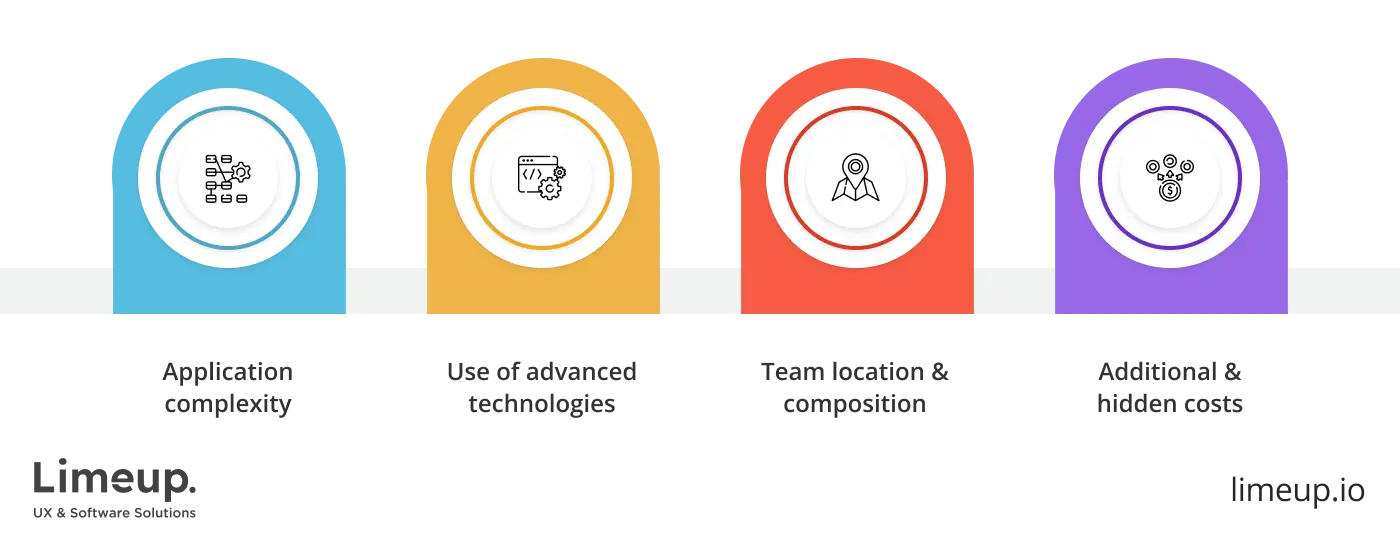
You can effectively supervise your costs by focusing on the core attributes you need at this stage of your firm expansion, as well as by choosing the right tech hub, which we can assist you with by creating a small guide in the next section.
How to choose a company for CRM development?
Choosing the right provider for CRM system development services is a crucial decision because it will greatly determine the success of the implementation. Take all the nuances into account at the initial stage. You will end up with a mechanism that is useful: you streamline your operations, improve lead relationships, and grow with your ambitions.
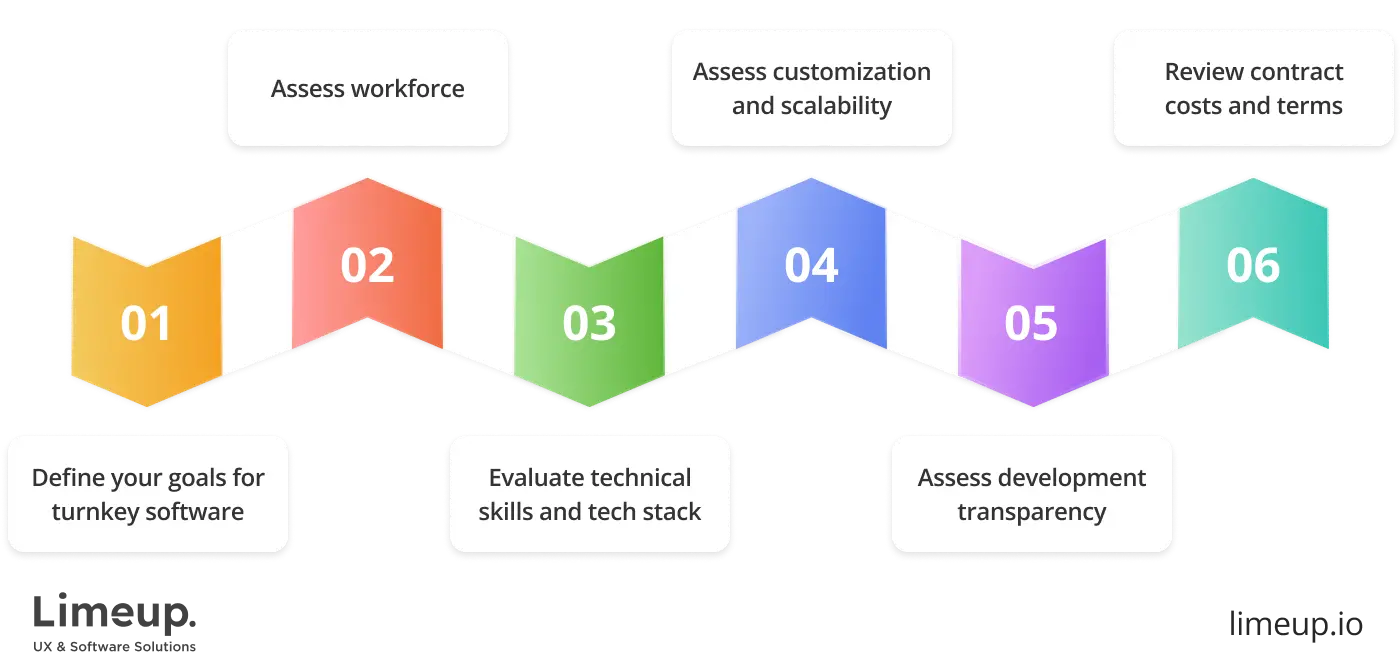
Here are some key factors to consider when choosing a supplier:
-
Understand what you want to get out of turnkey software. This could include questions like:
- What specific problems do you want to solve?
- What functions are essential to your entity?
- What integrations do you need?
- What is the timeline and budget?
The more clearly you formulate these inputs, the easier and more straightforward they will be to convey to a CRM software development company.
-
Review the industry experience and knowledge of the workforce. You want someone who has experience developing panels for players in your industry. So look for someone who has the following:
- Proven experience in sales automation software building
- Understanding the unique features of your niche
- Experience working with organizations of a similar size and format
- Portfolio of work with successful results
All this can be found by studying the venture’s websites, portfolio and prospect opinions.
-
Check technical skills and technology lineup. A reliable custom CRM software development company should be an expert in the latest technologies and frameworks, such as:
- Customer success platform programming languages (e.g., Java, PHP, .NET)
- Metadata coordination tools (e.g., MySQL, PostgreSQL, MongoDB)
- Cloud solutions (AWS, Azure, Google Cloud)
- AI and automation (chatbots, predictive analytics)
- API integration with third-party engines
As the squad’s proficiency with these packages increases, the likelihood that your CRM instrument board will be constructed on a scalable and promising platform will also enhance.
-
Evaluate the customization and scalability options. The main feature of individualized upshots is the flexibility to adapt to different needs. Based on this, ask if CRM software development companies can come up with the following parameters:
- Configurability (ability to change depending on different workflows)
- Scalability (potential growth of the output in line with the growing volume of parameters)
- Usability (intuitive to use without the need for long training)
-
Assess the level of transparency of the creation procedure. Those vendors of custom CRM development services who can really be trusted with such a business-critical construct follow a structured approach. Therefore, it is not a bad idea to clarify the nuances of the methodology:
- Do they adhere to the Agile, Scram, or Waterfall tactic?
- How do they manage project milestones and deadlines?
- What is the interaction style during the work?
- Do they propose regular updates and reports on the object’s formation?
This transparent and collaborative route ensures that they effectively produce a conception that you can not only be proud of but also see its positive impact on the establishment blooming on a daily basis.
-
Analyze the costs and terms of the contracts. Since the approach to pricing can vary significantly, it is worth discussing all controversial points before signing a contract with a CRM development company or a CRM consultant. It would be prudent to focus on those who present the subsequent options:
- Transparent pricing without hidden payments
- Flexible payment models, which can include both hourly rates and fixed amounts or staged payments depending on the specifics of your project
- Clear terms of the contract, which spell out the results, deadlines, assistance policy, and protocols for action in extraordinary situations
- A clearly defined agreement can protect you from possible misunderstandings and ensure long-term trusting relationships
The bottom line
A thoughtfully crafted and effectively implemented contact management solution empowers corporations to achieve significant results, converting users into dedicated supporters.
In our analysis, we endeavored to thoroughly explore how to create CRM software, incorporating insights into essential functionalities and key criteria for selecting a qualified provider. A meticulous review of these factors equips commercial houses to prioritize their focus and optimize resource allocation.
Investing in a client interaction construction represents a commitment to future growth; to ensure these investments yield maximum rewards, consider enlisting the guidance of experts with a proven track record in resolving similar challenges. Contact us for a complimentary consultation, where we will share our extensive knowledge to uphold and propel your business forward.

